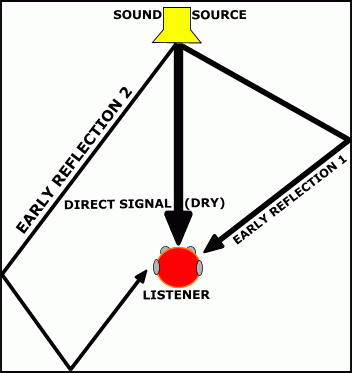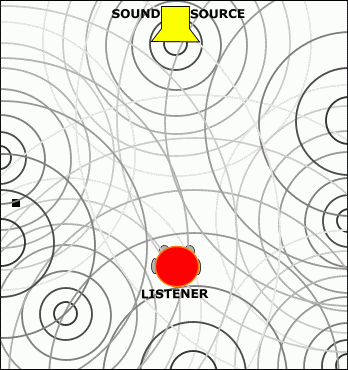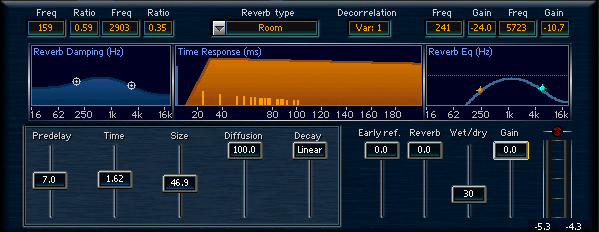Reverb
What is Reverb ?
A Reverb simulates the component of sound that results from reflections from surrounding walls or objects.
It is in effect a room simulator. Some peope think it's just a delay effect with some filters, but it's way
more complex than that. Reverb effects (software plugins or external hardware units) provide
an interface to their changable parameters that need some explaining. Let's look at a simple room first.
Basic Simulation of a Room
Our model is a simple room with four straight walls, a sound source and a listener. In Figure 1
the arrows stand for the path of travelling sound.
The listener hears the DIRECT signal first. The DIRECT signal is also referred to as the DRY part of the signal when using
any effect. Most digital reverbs produce two parts: The Early Reflections and the Reverb component.

Figure 1 |
The first Early Reflection reaches the listener milliseconds after
the direct signal does.
The path of the Early Reflections is longer. The difference in time between the arrival of
the direct signal and the first Early Reflections is measured in milliseconds.
|

Figure 1 |
The sound reflects off the walls and objects in the room, and in time individual reflections
disapear and the Reverb develops.
Predelay
The time between the reception of the DIRECT signal by the listener and start of the Reverb portion
of the effect is called Predelay. This is a parameter in many digital reverb effects, and it
is expressed in milliseconds (ms).
Reverb Time
The time difference between switching off any sound generator and the level of the reverb resulting
from that sound dropping by 60dB is called RT60.
This is usualy referred to as the Reverb Time. When anyone refers to the reverb time
of a real room or that of a digital reverb, RT60 is what they're talking about.
Most digital reverbs feature this as a parameter.
|
Common parameters of a digital Reverb
|
Usualy controlled via Room type and/or Room Size parameters.
The EARLY REFLECTIONS enable the human brain to quickly identify the room size. They are
therefore the most critical part of a reverb effect, if a room simluation is the goal.
|
|
Paramter Range : 0 to x milliseconds
Time between Direct Signal and start of Reverb portion.
The more space between you and walls or other reflective objects, the greater the Predelay.
|
|
Paramter Range : 0.1 to x.x seconds
The greater the enclosed(!) volume of the space you're in, the longer the reverb time. This is of course true only
to a certain extent. The larger the room or chamber, the louder your source signal needs to be to produce any
significant level of reverb tail. A good way to demonstrate this is to visit some huge cathedral and talk quietly.
Then yell a bit and you'll actualy hear some significantly loud reverb. The RT60 value is measured with a noise impuls, but the level
at which that impulse was sent out should be known too.
Many reverb effects let you set different reverb times for different frequency bands. Most reverb units on PC and Mac architectures provide two bands,
so you get to set the reverb time for each frequency band individualy.
|
|
Usualy a Hishelf and/or a Lowshelf EQ with variable Frequency.
These EQs are applied continously to an evolving reverb of a piece of audio.
Over time, as the reverb fades, so do certain frequencies, either in the lower
or higher frequency range. The more less-reflective surfaces the sound bounces
around from, the more the reverb is dampened the higher frequencies.
Freeverb features a Damping parameter that dampens the upper frequencies.
|
|
Usualy a Hishelf and/or Lowshelf EQ with variable Frequency.
These EQs are only applied to the output of the reverb or perhaps even just the reverb portion
of the Reverb effect. Some reverbs have Hishelf and Lowshelf EQs for the Early Reflections as well.
Freeverb has both a Hicut and Lowcut parameter.
|
Here's a screenshot taken from the reverb plugin Renaissance Reverberator by Waves.

reproduced with permission
Here we have the Hishelf and Lowshelf EQs for Damping(left) and for the final output(right). The upper middle display
depicts the Early Reflections placement and level, as well as the Reverb portion start and fading. Above this display
is the Reverb Type selector. This changes the placement and level of the Early Reflections. The Size slider
has influence on the Early Reflections as well.
Blank concrete will reflect sound quite well across the frequency spectrum. A large thick curtain
or padded walls will reflect sound poorly. A large club filled with people sounds completly different
from an empty one. People, comfy chairs, curtains, carpets, beds and many more objects reflect only
part of the sound that hits them.


